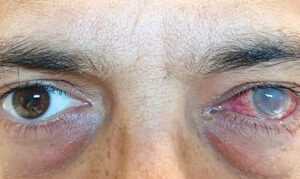
A 44-year-old man with diabetes and end-stage kidney disease recently experienced a severe case of bacterial endogenous endophthalmitis, a vision-threatening infection of the eye. Despite treatment, his vision did not improve, highlighting the severity and complexity of this condition.
Key Points:
- The patient presented with a 2-week history of pain and blurry vision in his left eye, fevers, and back pain.
- An ophthalmologic examination revealed conjunctival injection and corneal clouding in the left eye.
- Cultures of vitreous fluid and blood grew methicillin-sensitive Staphylococcus aureus.
- The infection is deemed to be endogenous when it results from hematogenous spread.
- Systemic antimicrobial agents alone will not adequately treat endogenous endophthalmitis.
- Intravitreal antimicrobial therapy is warranted, and vitrectomy is indicated in cases of severe vision loss or progression of infection despite antimicrobial therapy.
- Further imaging identified paraspinal muscle abscesses and mitral valve endocarditis.
- Treatment with intravitreal antimicrobial agents and an 8-week course of intravenous cefazolin was initiated.
- A vitrectomy was not performed owing to the relatively late clinical presentation.
- At a 2-month follow-up visit, the patient’s vision had not improved

According to the American Academy of Ophthalmology, endophthalmitis occurs in approximately 0.04% of cataract surgeries, one of the most common causes of this condition.
More in Ophthalmology
